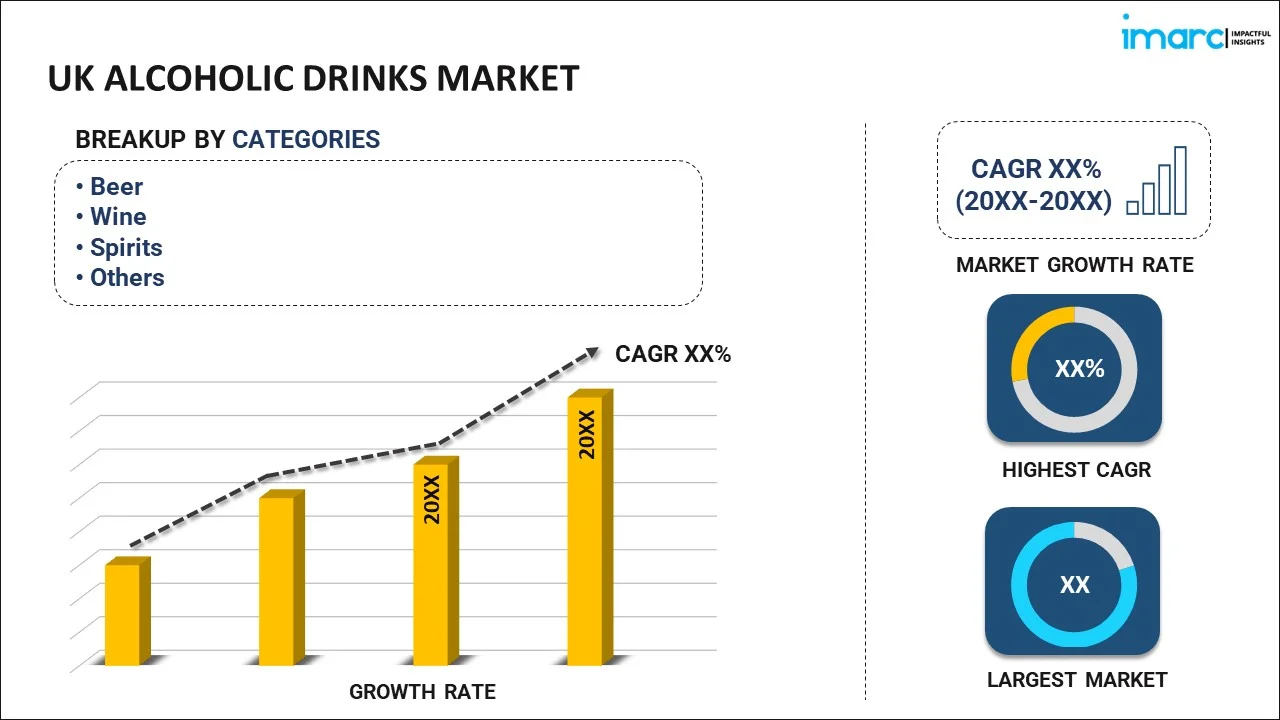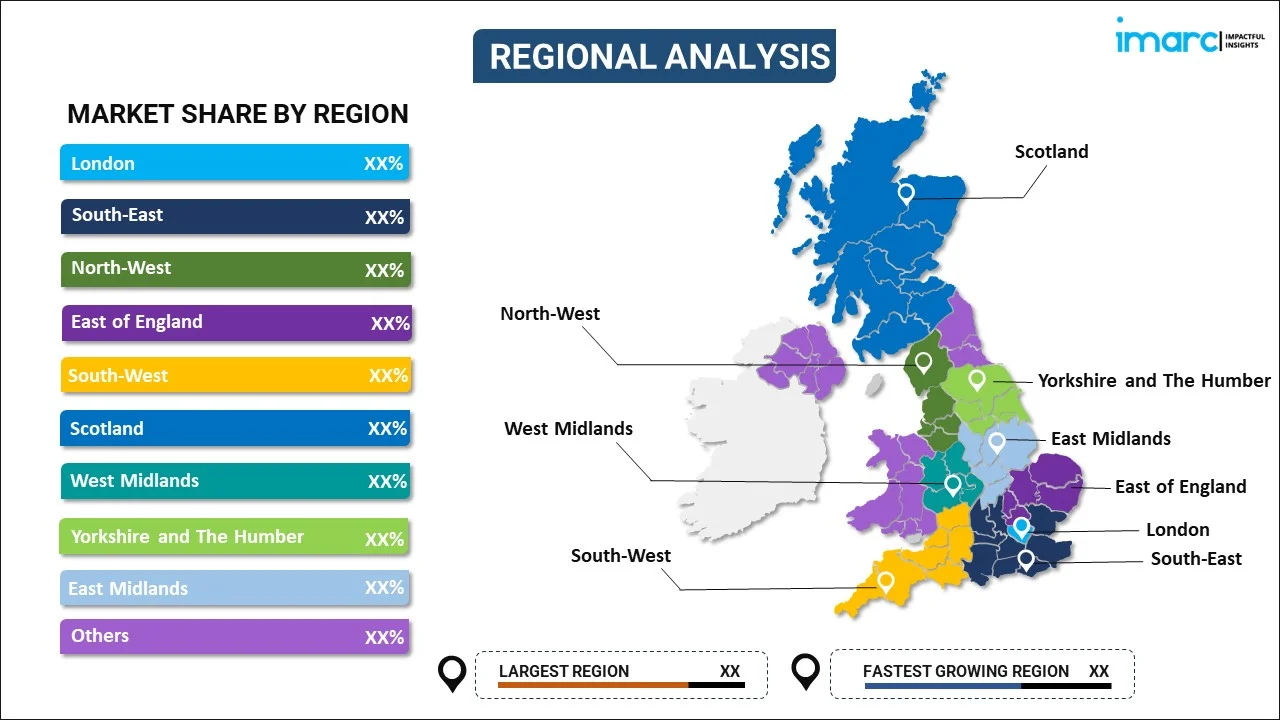
UK Alcoholic Drinks Market Report by Category (Beer, Wine, Spirits, and Others), Alcoholic Content (High, Medium, Low), Flavour (Unflavored, Flavored), Packaging Type (Glass Bottles, Tins, Plastic Bottles, and Others), Distribution Channel (Supermarkets and Hypermarkets, On-Trade, Specialist Retailers, Online, Convenience Stores, and Others), and Region 2025-2033
UK Alcoholic Drinks Market Overview:
The UK alcoholic drinks market is projected to exhibit a growth rate (CAGR) of 4.10% during 2025-2033. The increasing consumer demand for craft and premium beverages, the rising popularity of low and no-alcohol alternatives, evolving consumer tastes towards innovative flavors, and the influence of social trends on drinking habits are some of the factors contributing to the market growth.
|
Report Attribute
|
Key Statistics
|
|---|---|
|
Base Year
|
2024 |
|
Forecast Years
|
2025-2033
|
|
Historical Years
|
2019-2024
|
| Market Growth Rate (2025-2033) | 4.10% |
UK Alcoholic Drinks Market Trends:
Shift towards premiumization and the consumption of craft beverages
Consumers are increasingly willing to spend more on high-quality alcoholic drinks, driven by factors such as increased disposable incomes, a desire for unique and artisanal products, and a growing appreciation for quality over quantity. This trend is noticeable across various categories, such as boutique wines, premium spirits, and craft beers. For example, craft beers have become increasingly popular owing to their unique flavors, appeal to local producers, and the skillful brewing processes they require. Similarly, premium spirits have benefited from consumers' willingness to explore and indulge in high-end whiskies, gins, and vodkas, often driven by the desire for a superior drinking experience and the status associated with premium brands, providing an impetus to the market growth.
Innovation in Flavors and Formats
Innovation in flavors and formats is significantly driving the UK alcoholic drinks market, appealing to consumers seeking novel experiences. Unique flavor profiles, such as those incorporating spices, exotic fruits, and botanical infusions, are being introduced to the market to appeal to palates that are daring and to improve the drinking experience. Additionally, new product designs that suit modern lifestyles and offer convenience include canned wines, hard seltzers, and ready-to-drink (RTD) cocktail kits. Those looking for on-the-go solutions and younger demographics are majorly influenced by these stylish and portable options. This continuous innovation refreshes the market and attracts diverse consumer segments, strengthening the overall growth and dynamism of the industry.
Rising E-commerce
The digital revolution has transformed the way alcoholic drinks are marketed, distributed, and consumed in the UK. Online retail channels have become increasingly popular, offering consumers convenient access to a wide range of products, from global brands to local favorites. E-commerce platforms and direct-to-consumer (D2C) sales have democratized access to niche and specialty products that may not be readily available in traditional brick-and-mortar stores. Moreover, social media platforms have emerged as powerful influencers in shaping consumer preferences and driving trends within the industry. From viral cocktail recipes to influencer endorsements, digital platforms play a crucial role in amplifying brand visibility and engaging with consumers in new and interactive ways, bolstering the market growth.
UK Alcoholic Drinks Market News:
- In February 2024, Diageo, owner of Johnnie Walker, is launching a premium RTD cocktail collection in the UK, featuring a Johnnie Walker Old Fashioned (20.5% ABV), Tanqueray Negroni (17.5% ABV), and Cîroc Cosmopolitan (17.5% ABV). Each 500ml bottle, priced at £15, offers five servings and will be available in supermarkets from March, with 100ml cans following in April. The goal of this launch is to capitalize on the growing consumer trend of creating cocktails at home as well as the growing interest in premium spirits.
UK Alcoholic Drinks Market Segmentation:
IMARC Group provides an analysis of the key trends in each segment of the market, along with forecasts at the country level for 2025-2033. Our report has categorized the market based on category, alcoholic content, flavour, packaging type, and distribution channel.
Category Insights:

- Beer
- Wine
- Still Light Wine
- Sparkling Wine
- Spirits
- Baijiu
- Vodka
- Whiskey
- Rum
- Liqueurs
- Gin
- Tequila
- Others
- Others
The report has provided a detailed breakup and analysis of the market based on the category. This includes beer, wine (still light wine and sparkling wine), spirits (baijiu, vodka, whiskey, rum, liqueurs, gin, tequila, and others), and others.
Alcoholic Content Insights:
- High
- Medium
- Low
A detailed breakup and analysis of the market based on the alcoholic content have also been provided in the report. This includes high, medium, and low.
Flavour Insights:
- Unflavoured
- Flavoured
The report has provided a detailed breakup and analysis of the market based on the flavour. This includes unflavored and flavored.
Packaging Type Insights:
- Glass Bottles
- Tins
- Plastic Bottles
- Others
A detailed breakup and analysis of the market based on the packaging type have also been provided in the report. This includes glass bottles, tins, plastic bottles, and others.
Distribution Channel Insights:
- Supermarkets and Hypermarkets
- On-Trade
- Specialist Retailers
- Online
- Convenience Stores
- Others
The report has provided a detailed breakup and analysis of the market based on the distribution channel. This includes supermarkets and hypermarkets, on-trade, specialist retailers, online, convenience stores, and others.
Regional Insights:

- London
- South East
- North West
- East of England
- South West
- Scotland
- West Midlands
- Yorkshire and The Humber
- East Midlands
- Others
The report has also provided a comprehensive analysis of all the major regional markets, which include London, South East, North West, East of England, South West, Scotland, West Midlands, Yorkshire and The Humber, East Midlands, and Others.
Competitive Landscape:
The market research report has also provided a comprehensive analysis of the competitive landscape. Competitive analysis such as market structure, key player positioning, top winning strategies, competitive dashboard, and company evaluation quadrant has been covered in the report. Also, detailed profiles of all major companies have been provided.
UK Alcoholic Drinks Market Report Coverage:
| Report Features | Details |
|---|---|
| Base Year of the Analysis | 2024 |
| Historical Period | 2019-2024 |
| Forecast Period | 2025-2033 |
| Units | Billion US$ |
| Scope of the Report | Exploration of Historical Trends and Market Outlook, Industry Catalysts and Challenges, Segment-Wise Historical and Future Market Assessment:
|
| Categories Covered |
|
| Alcoholic Contents Covered | High, Medium, Low |
| Flavours Covered | Unflavored, Flavored |
| Packaging Types Covered | Glass Bottles, Tins, Plastic Bottles, Others |
| Distribution Channels Covered | Supermarkets and Hypermarkets, On-Trade, Specialist Retailers, Online, Convenience Stores, Others |
| Regions Covered | London, South East, North West, East of England, South West, Scotland, West Midlands, Yorkshire and The Humber, East Midlands, Others |
| Customization Scope | 10% Free Customization |
| Post-Sale Analyst Support | 10-12 Weeks |
| Delivery Format | PDF and Excel through Email (We can also provide the editable version of the report in PPT/Word format on special request) |
Key Questions Answered in This Report:
- How has the UK alcoholic drinks market performed so far and how will it perform in the coming years?
- What has been the impact of COVID-19 on the UK alcoholic drinks market?
- What is the breakup of the UK alcoholic drinks market on the basis of category?
- What is the breakup of the UK alcoholic drinks market on the basis of alcoholic content?
- What is the breakup of the UK alcoholic drinks market on the basis of flavour?
- What is the breakup of the UK alcoholic drinks market on the basis of packaging type?
- What is the breakup of the UK alcoholic drinks market on the basis of distribution channel?
- What are the various stages in the value chain of the UK alcoholic drinks market?
- What are the key driving factors and challenges in the UK alcoholic drinks?
- What is the structure of the UK alcoholic drinks market and who are the key players?
- What is the degree of competition in the UK alcoholic drinks market?
Key Benefits for Stakeholders:
- IMARC’s industry report offers a comprehensive quantitative analysis of various market segments, historical and current market trends, market forecasts, and dynamics of the UK alcoholic drinks market from 2019-2033.
- The research report provides the latest information on the market drivers, challenges, and opportunities in the UK alcoholic drinks market.
- Porter's five forces analysis assist stakeholders in assessing the impact of new entrants, competitive rivalry, supplier power, buyer power, and the threat of substitution. It helps stakeholders to analyze the level of competition within the UK alcoholic drinks industry and its attractiveness.
- Competitive landscape allows stakeholders to understand their competitive environment and provides an insight into the current positions of key players in the market.
Need more help?
- Speak to our experienced analysts for insights on the current market scenarios.
- Include additional segments and countries to customize the report as per your requirement.
- Gain an unparalleled competitive advantage in your domain by understanding how to utilize the report and positively impacting your operations and revenue.
- For further assistance, please connect with our analysts.
 Inquire Before Buying
Inquire Before Buying
 Speak to an Analyst
Speak to an Analyst
 Request Brochure
Request Brochure
 Request Customization
Request Customization




.webp)




.webp)












